The Great Replanting I: On Winning
Lessons from shelterbelts and coyotes in the age of doggy boys
Apologia: I had a lot to get off my chest this week, so pardon my french.
Beyond that, the following post may seem to suggest that efforts to influence our policy-makers are hopeless. History suggests otherwise— but I’m not particularly confident in our current power structure. Ultimately, I am neither fully for nor against the apparatus of state, as the essay will further explain, but I am for whatever does the greatest good. Call your elected officials, or don’t. But let’s plant some damn trees either way.
I will elaborate on strategies in a future piece.
Apologetically myself,
BB
In the heat of dog days without rain, when flaming wind whips the dusty cottonwood leaves that glare with hot sunlight filtered through a haze of brimstone air that creeps south from ceaseless Canadian wildfire, I take shelter in the trees– along with the swine and fowl and ruminating cattle. Birds are here with us too: indigo buntings, summer tanagers, and the occasional cuckoo. The undersides of heat battered leaves squirm with larvae, and mantises and wheelbugs edge along the whipping fronds of willow an mulberry to prey upon the burgeoning life, the ecological cycle –the circle of solar energy itself– unbroken, in spite of this harsh summer. As a livestock person –and a prairie person– grass and grazing are a key component of my livelihood and my joy. But without these trees which block the wind, hold and nourish the earth, and offer shade and shelter, we might all perish– me, the cows, the cuckoos, the wheelbugs, and the prairie itself.
When the creek runs low, choked with mud– a winding course of muck meandering through the bottomlands that thrum with cicadas –better suited to raccoons, deer and mosquitos than fish, ducks, or beavers– we take to the timber, braiding our garlic, picking through berry baskets, and even resting in hammocks, where the harsh sun doesn’t reach. The cows chew cud and swat flies in the embrace of cottonwood and boxelder. The pigs snore ‘neath cedar, and the chickens dust themselves and pant in the calm of oakleaf shade. Without a few trees –and there are in fact some farms around here like that– the heat of even a moderate August, like we’ve enjoyed thus far, would be overwhelming… nevermind late in the month when the winds typically blow swift and dry, or a climate quickly becoming hotter and harsher with each year.
Even since our descent from the trees onto the savanna as early, pack hunting apes, we’ve remained fairly near to them. They are familiar oases spread across the broiling expanse of buzzing grasses in the summer. They form protective walls for us as we trudge through blizzards and wind, and even keep us dry in the gully-washer torrents that rupture the humid air. When stewarded with care they feed us with their flesh and seed, and form the backbones of our homes. Trees are so intimately tied to human survival that their popularity is probably only surpassed by potable water and breathable air– or at least that was the case until trees became woke.
Folks, this has never been an explicitly political publication– it just so happens that the things I write about, like plants, dirt, food, climate and animals, have been given a political dimension by those who seek power, profit, and control. Land –who owns it, and how it is stewarded– is an inherently political subject in this age of extraction. This is a pretty old story, dating to at least the dawn of agriculture, and probably before. And lately, it seems to have become pretty damned silly– and also fairly grave.
You may recall a few short months ago (though it feels like eons at this point), when Elon Musk and his DOGE gang (pronounced “doggy”, I think) took the reins of the federal budget, which appears fairly unconstitutional, not that I trust the Supreme Court to make that determination. This group of young libertarians (the worst kind of libertarian in my book is the libertarian who has spent their entire life living with their parents) used among other things, faulty AI tools to search for “woke” ideology within federal programs. So cool. From the USDA’s avian flu response and the suspension of VA cancer services to the dismissal of thousands of federal workers, these deeply flawed human beings and their deeply flawed inhuman tools broke a lot of things in a short amount of time, the very things that I prefer a government to be working on.
I’d prefer to not linger on these individuals much more (other than perhaps this), but here’s where we bring it back to trees. At the peak of DOGE’s power (again, pronounced “doggy”), I was among the thousands of farmers who had grant funding terminated as part of this purge. The Partnerships for Climate-Smart Commodities program was a modestly ambitious undertaking in a burning world, and it was essentially tanked by some pubescent trolls and the weird older guy who was hanging out with them. Included in the cancelled program was an even more modestly ambitious sub-program, known as “Expanding Agroforestry Production & Markets for Producer Profitability and Climate Stabilization”, or EAP, which would have funded 30,000 acres of tree-based agriculture. EAP may not have fixed the immeasurable environmental issues tied up in agriculture, but it would have been a functional demonstration of how we could.
I don’t really know what “woke” ideology is anymore, but I’m fairly certain that a desire to see our children and grandchildren inhabit a liveable planet is, much like a fondness for trees, less an ideological or political stance, and more of a basic evolutionary reflex for our species. Lots of people plant trees– on farms, in cities, wherever they’re needed or desired. Survival is not an ideology. I’ve personally moved on from the disappointment in the termination of this particular program and have found ways to plant trees regardless of federal support, but the question has been nagging me for months now– what will it take for human culture to adapt and respond to the destruction it has wrought upon the earth?
As an individual, I can plant many trees in a limited space. As part of a cooperative, I can plant a few more than that. At best, individual action (or private enterprise) in regards to agroforestry, regenerative agriculture, or other sound, sustainable forms of land stewardship, while earnest, is limited and strategically fractured in comparison to the incredible power for action that our global seat of power –states, militaries, and corporations– hold. And in the not-to-distant past, the state has in fact mobilized to check and mitigate massive scale environmental catastrophes.
“Creeping halfway across the Nation in a murky cloud extending 10,000 feet into the sky, the great dust storm of the Southwest and Midwest invaded the East yesterday, bringing grime and discomfort on the first day of spring.
Even as the Administration determined upon a combined drive by seven government agencies to fasten the Midwest's rich farm soil against the destructive dust storms, the swirling particles of earth from Kansas, Oklahoma and Texas sifted into the District and dirtied the windows of Federal Buildings.
To a large extent the storm, which traveled at an estimated speed of 35 miles an hour, passed to the north of the Capital, but by late afternoon it was distinctly visible here. A clay-colored veil hung before the Washington Monument, the Lincoln Memorial, the Capitol and the Library of Congress.”
The Washington Post, 3/22/1935
Hugh Hammond Bennet (April 15, 1881 – July 7, 1960), Director of the newly founded Soil Erosion Service, was testifying to Congress on the day that the dust bowl came to Washington DC. It must have made some impact. Earlier in Bennet’s career, he was often dismissed for his views on the link between erosion and soil quality. One of his USDA supervisors reportedly responded to Bennet’s warnings about soil loss by stating that "the soil is the one indestructible ... asset the nation possesses ... It is the one resource that cannot be exhausted." By 1935, as he lectured lawmakers, the midday sun a faint glow in the wall of dark, airborne earth that slid down the cracks and gaps of the Capitol Hill dome and into the chamber, it had become obvious –even to Congress– that action needed to be taken.
The dust bowl era was brought about by a cascade of ecological and economic factors. In the post World War boom, the Southern Great Plains saw an explosion of homestead settlement, and the market gap in wheat production left by a European continent devastated by war was quickly filled by speculative farmers who tilled millions of acres of shortgrass prairie ecosystems in Oklahoma, Texas, New Mexico, and Colorado. The first few years of this boom were profitable– relatively mild, wet growing seasons and the short term fertility boost that comes with pulverizing a 10,000 year old ecosystem made sod-busting a winning proposition, to the point that “suitcase farmers”, men from the east who couldn’t tell which end of the shovel goes in the dirt, purchased vast tracts of land to make it in the wheat business.
By the end of the 1920’s, the Southern Great Plains entered a period of extreme drought, as it is prone towards, and nearly simultaneously, the economy entered a Great Depression. The price of wheat plummeted, so farmers attempted to make up for low prices with greater production– further tilling and stripping the dry soil, which field by field and year by year, would blow away. The intervening years –between the destruction of these prairie soils– and their gradual rehabilitation through soil conservation practices promoted by Hugh Bennet were a living hell (check out the Timothy Egan book “The Worst Hard Time” for a harrowing account of all the black blizzards, dust pneumonia, locusts, and starvation). Those on the front lines of the dust bowl needed help for years, but it wasn’t until the middle of the 1930’s, when the Oklahoma dust began to carry into population centers like Chicago, New York, and Washington DC, that the situation –and Hugh Bennet’s conservation solutions– began to be taken seriously.
In other words, shit had to hit the fan. The centers of power had to breathe the dust that was killing faraway children for years for the political will to develop. Perhaps, it had to be their children next.
It took some years for the dust to settle, so to speak. Bennet’s work lead to the creation of the Soil Erosion Service, now known as the Natural Resource Conservation Service– one of the only remaining New Deal agencies still in existence. The federal government offered assistance in putting row-crops back into pasture, and employing contoured tillage instead of more damaging techniques for those areas more suitable to grain production. In the first 18 months of these programs, nearly half of the 5.5 million acres of dangerously eroded wasteland had been mitigated, employing nearly 40,000 previously out-of-work laborers.
Another hallmark of these grand, early mitigation efforts was the Great Plains Shelterbelt– a hundred mile wide strip of trees planted for windbreak and erosion control, running from border of Canada and North Dakota down to the Brazos river valley in Texas: 220 million trees in all, spread across 18,600 square miles. While the EAP was a significant loss for a lot of folks, it would not have come near the level of impact of the Great Plains Shelterbelt in terms of sheer scale. After nearly a century, it remains the singularly largest and most focused attempt by our government to address an environmental problem.
The program was set to last 12 years, the first very first tree –an Austrian pine– being planted on a farm in Willow, Oklahoma in 1935. As the longer term climate cycle reverted back out of drought in the early 1940’s, and politicians began squabbling about the shelterbelt’s continual funding, it was ultimately cut short in 1942, as America entered World War II. Many of the original plantings have gone unmaintained, or been bulldozed in subsequent decades, even while minor dust bowl events have cropped up in the ‘50’s, 70’s, and early ‘00’s. Recently, the NRCS has helped to restore remnant shelterbelt plantings across the great plains.
China, the Soviet Union, and the African Union have all undertaken similar “Great Green Wall” type plantings to ward off erosion and desertification, to mixed effect. In the years since the Great Plains shelterbelt, our generalized understanding of ecology and effective tree cropping have improved dramatically– and while afforestation as a singular mode for carbon storage is limited, it does provide a wide array of ecological and economical benefits for working lands. Alongside riparian, ocean and grassland repair, these types of projects are practical to physically implement, address multiple environmental concerns, and are broadly popular to the average person, in comparison to untested techno-fixes to climate change. The only other effective, physically tangible approach to environmental destruction and climate change that I can think of would be to relegate the small handful of folks who do not exercise their power to fix it, alongside the CEO’s who created it, to the bottom of the ocean– a process that would require less than a semi-load of concrete block, a few thousand feet of rope, and some talented wranglers.
It has rained since the morning chores today, through two pairs of pants and two pairs of boots, with no sign of letting up. The risk for a dustbowl in Northeast Missouri is currently low. The muddy trickle of the old creek has begun to swell slightly. One reason that the dust bowl was straightforward to address was the singular simplicity of it– it was one closely related set of symptoms, centralized in one general region. The challenge of climate survival is different– complex, difficult to comprehend, largely unpredictable at times. Whereas the dust bowl was a hard-edged, definable event, climate change is in many ways softer, stranger, undefined. Windswept soil is unlikely to inundate Capitol Hill anytime soon, and if it did it would merely be ignored and denied: at this point, I think it could be objectively stated that the American lawmaker is perhaps the lowest expression of contemporary human morality. We all know this; they are dishonest, greedy, corrupt, and ethically bankrupt. But what I don’t see folks calling out is that these people are, above all, losers. I have no doubt that if I had their power, if you, dear reader, had that power, that we wouldn't be content to watch the world burn and flood. We wouldn’t be content to watch our species and countless others die out. Having that power, and doing nothing with it, is loser shit. I want to win.
The political will to implement the Great Plains Shelterbelt didn’t come from a desire to win, either. It came from an instinctual drive to survive– that behavior which so many organisms exhibit, to shelter in the trees. It did not arise until the bottom had completely dropped out of the economy, and the wasteland quite literally came lapping at the gates of power. But to implement it, the federal government had to at least support the basic research of people like Hugh Bennet– something our current administration is unwilling to do. Save for a few radical and unlikely tactics that wouldn’t be in my best interest to endorse or describe, things are just going to get worse. Loathe as I am to say it, the best we can do is learn to survive together, and hope that the fear of those in power can outpace the cascading set of geo-physical, on-the-ground consequences of such inaction.
But survivors can also be winners– and that’s why I want to survive. In the early 1900’s, during the wideswept destruction of the Great Plains, during the initial seeding of the dust bowl, our federal government formed an agency tasked with eliminating coyotes from range lands. In 1915, Congress appropriated money for trapping, shooting, and poisoning coyotes through the deceptively titled USDA Bureau of Biological Survey (if only the doggy boys had been there to stop it). The eradication efforts, targeting coyotes as well as wolves and bears, were renewed again in 1935, the same year that the first Austrian pine was planted on the Great Plains Shelterbelt.
Using aerial machine gunning, cyanide bombs, and strychnine bait among other tactics, the wolf and bear populations plummeted. But the coyote has only expanded its range across the continent, prowling across the post-war suburban sprawl, eating our chihuahuas. The coyote, it would seem, is winning. And so while federally focused power and funding can build massive shelterbelts, I would argue that these efforts only worked in accordance with a set of natural limits. Those efforts which work against the natural limits of the planet are ultimately doomed to fail. If we cannot receive support from our own government, then let’s be more like coyotes. Let’s survive regardless. And win.
The morning rain has stopped, and gusts of hot wind are howling across the cottonwood leaves again. The cattle have quit resting in their cover, and are back in the grass, chewing and swatting undisturbed. The pigs remain calm and snoring. The cuckoos shake their wet wings, and down along the soft edge of prairie-slope, hundreds of young trees we’ve planted are flashing resplendent in the returning sun. It is a small planting in regards to our big issues, but having successfully implemented it has now freed me to do another one next year, with or without federal funding. My back of the envelope math suggests that at this point, our little agroforestry collective is on track to retain five and half acres of soil for the next 50 years, and generate just shy of a million calories for human consumption annually, starting in under a decade. I hope to do it again and again, and make it appealing to my neighbors, and help them out with whatever they need, whenever I can. Because to do anything less with my power would be loser shit.



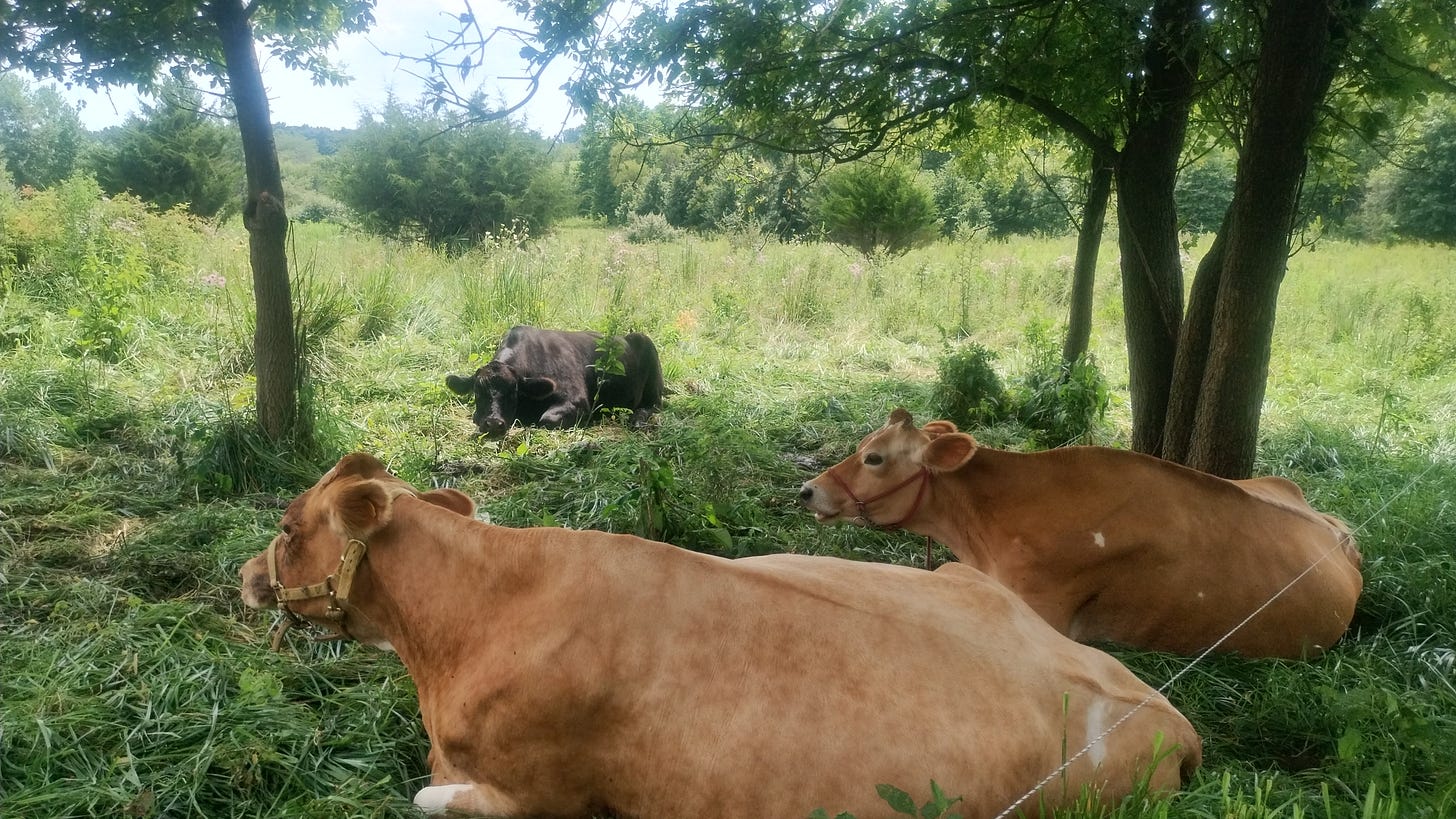
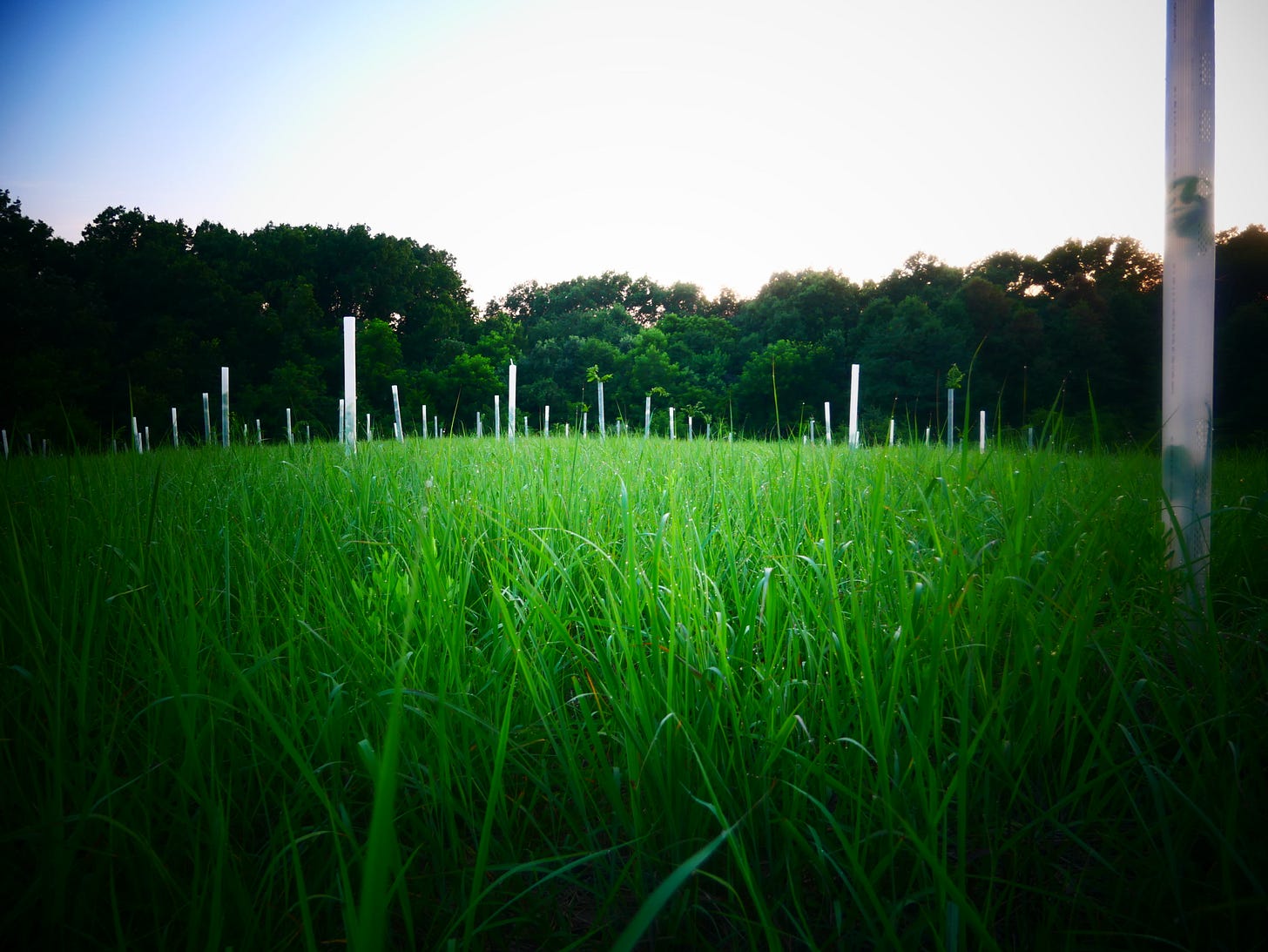
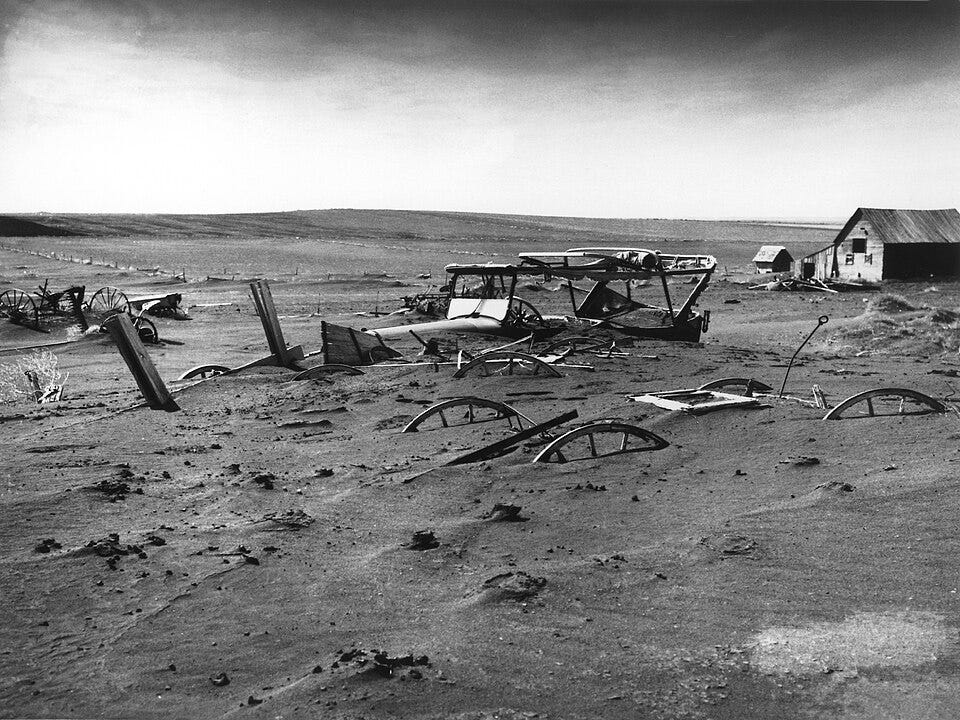

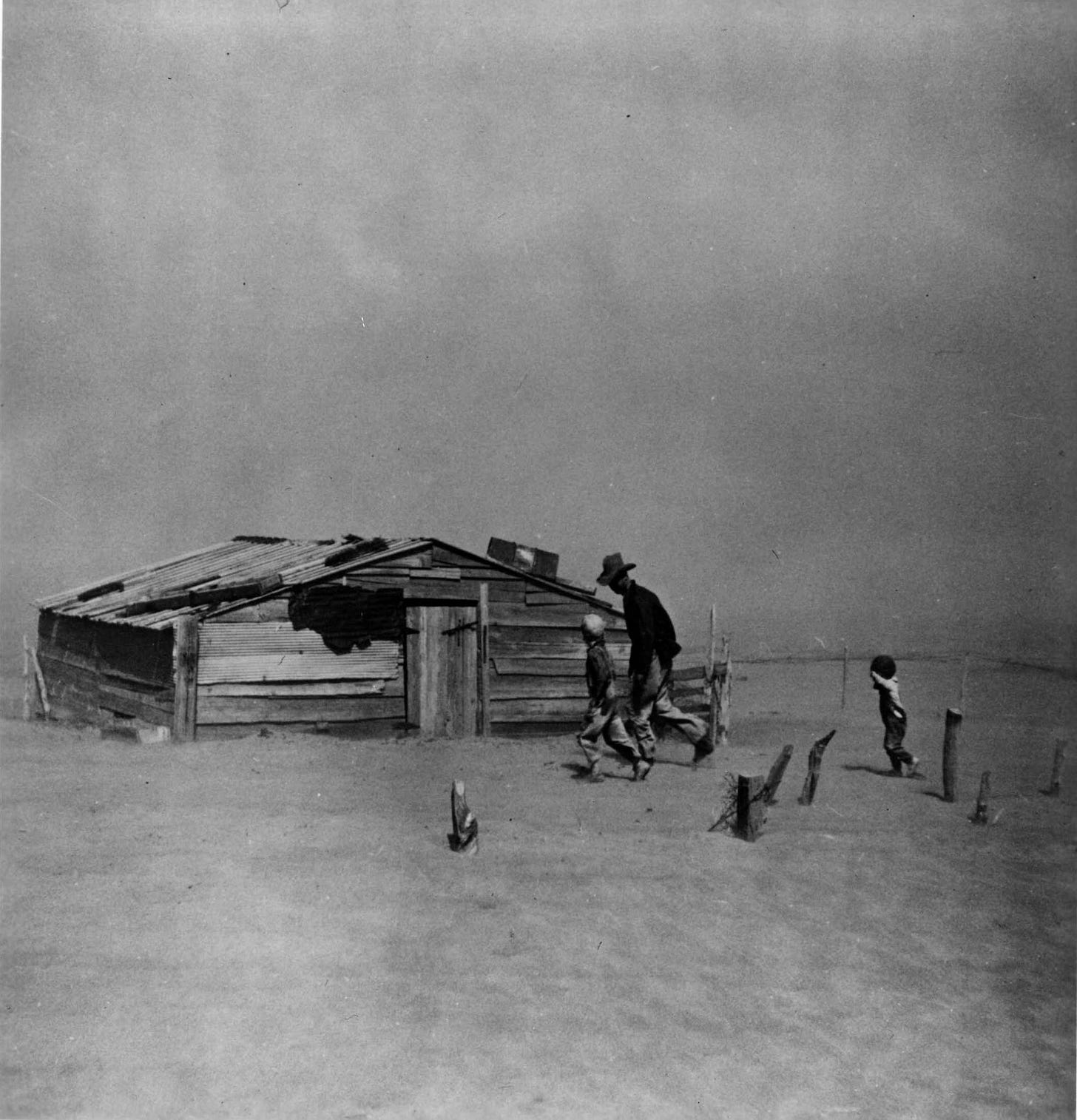

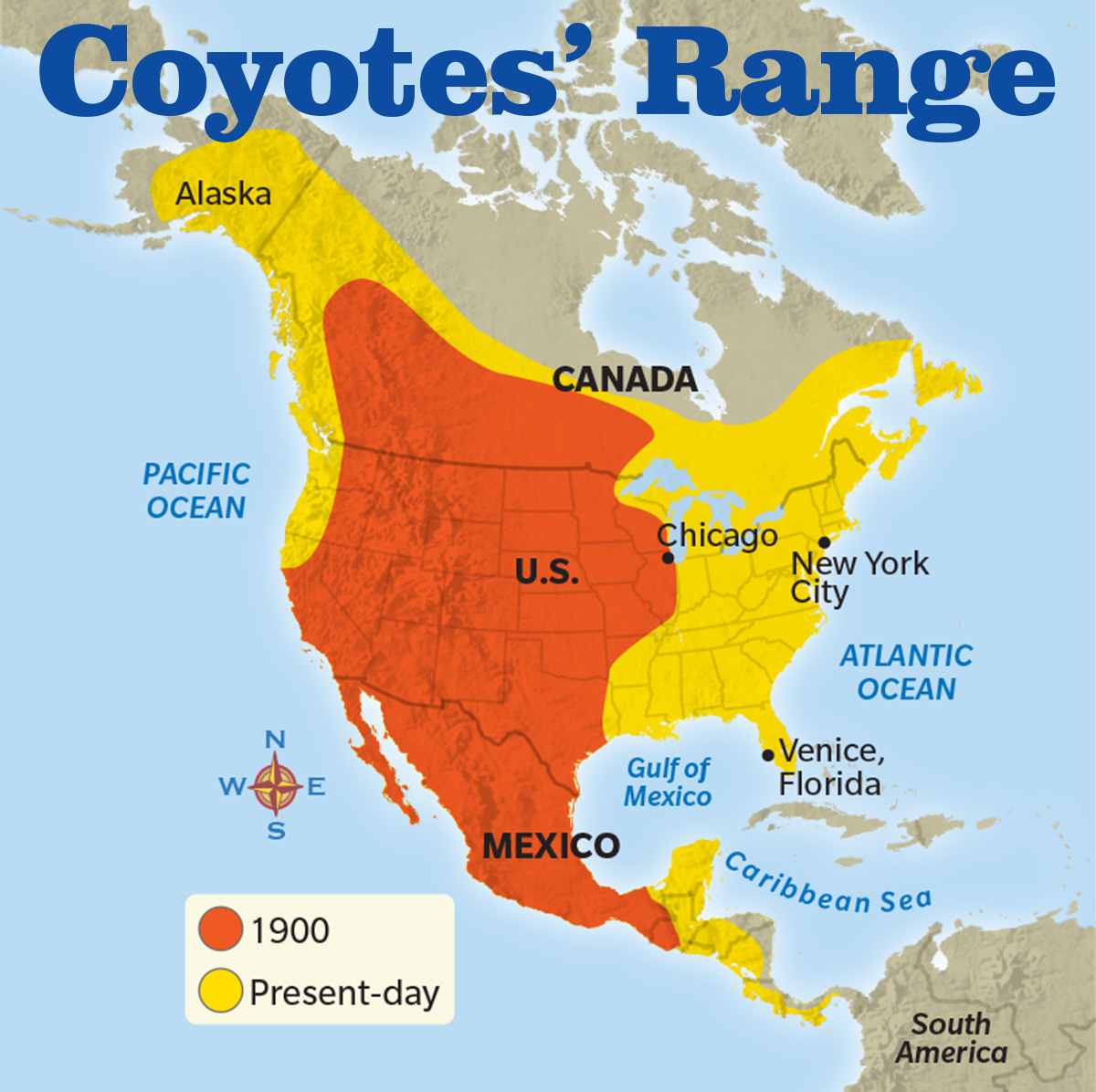
I learned so much from this excellent post! Yesterday, I was in a thrift store and saw a copy of "The Worst Hard Time," snagged it up because of this piece. Many thanks for all you do.
I am all for building a community of survivors. This is a beautiful idea.
I just wish fewer people had thrown in their lot with the losers.